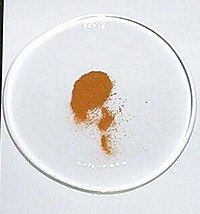Silver(I) fluoride
 |
|
 |
|
| Names | |
|---|---|
|
IUPAC name
Silver(I) fluoride
|
|
| Identifiers | |
|
7775-41-9 |
|
| 3D model (Jmol) | Interactive image |
| ECHA InfoCard | 100.028.996 |
| PubChem | 62656 |
| RTECS number | VW4250000 |
|
|
| Properties | |
| AgF | |
| Molar mass | 126.87 g·mol−1 |
| Appearance | yellow-brown solid |
| Density | 5.852 g/cm3 (15 °C) |
| Melting point | 435 °C (815 °F; 708 K) |
| Boiling point | 1,159 °C (2,118 °F; 1,432 K) |
| 85.78 g/100 mL (0 °C) 119.8 g/100 mL (10 °C) 179.1 g/100 mL (25 °C) 213.4 g/100 mL (50 °C) |
|
| Solubility | 83g/100 g (11.9 °C) in hydrogen fluoride 1.5g/100 mL in methanol(25 °C) |
| −36.5·10−6 cm3/mol | |
| Structure | |
| cubic | |
| Thermochemistry | |
| 48.1 J/mol·K | |
|
Std molar
entropy (S |
83.7 J/mol·K |
|
Std enthalpy of
formation (ΔfH |
-206 kJ/mol |
|
Gibbs free energy (ΔfG˚)
|
-187.9 kJ/mol |
| Hazards | |
| Main hazards | Corrosive |
| GHS pictograms |  |
| GHS signal word | Danger |
| H314 | |
| P280, P305+351+338, P310 | |
|
EU classification (DSD)
|
|
| R-phrases | R23/24/25, R34 |
| S-phrases | S13, S22, S24/25, S26, S36/37/39, S45 |
| NFPA 704 | |
| Related compounds | |
|
Other anions
|
Silver(I) oxide Silver(I) chloride |
|
Other cations
|
Copper(I) fluoride Gold(I) fluoride |
|
Related compounds
|
Silver subfluoride Silver(II) fluoride |
|
Except where otherwise noted, data are given for materials in their standard state (at 25 °C [77 °F], 100 kPa).
|
|
|
|
|
| Infobox references | |
Silver(I) fluoride is the inorganic compound with the formula AgF. It is one of the three main fluorides of silver, the others being silver subfluoride and silver(II) fluoride. AgF has relatively few niche applications; it has been employed as a fluorination and desilylation reagent in organic synthesis and in aqueous solution as a topical caries treatment in dentistry.
The hydrates of AgF present as colourless, while pure anhydrous samples are yellow.
High-purity silver(I) fluoride can be produced by the heating of silver carbonate to 310 °C under a hydrogen fluoride environment, in a platinum tube:
Laboratory routes to the compound typically avoid the use of gaseous hydrogen fluoride. One method is the thermal decomposition of silver tetrafluoroborate:
In an alternative route, silver(I) oxide is dissolved in concentrated aqueous hydrofluoric acid, and the silver fluoride is precipitated out of the resulting solution by acetone.
The structure of AgF has been determined by X-ray diffraction. At ambient temperature and pressure, silver(I) fluoride exists as the polymorph AgF-I, which adopts a cubic crystal system with space group Fm3m in the Hermann–Mauguin notation. The rock salt structure adopted by the other silver monohalides. The lattice parameter is 4.936(1) Å, significantly lower than those of AgCl and AgBr.Neutron and X-ray diffraction studies have further shown that at 2.70(2) GPa, a structural transition occurs to a second polymorph (AgF-II) with the caesium chloride structure, and lattice parameter 2.945 Å. The associated decrease in volume is approximately ten percent. A third polymorph, AgF-III, forms on reducing the pressure to 2.59(2) GPa, and has an inverse nickel arsenide structure. The lattice parameters are a = 3.244(2) Å and c = 6.24(1) Å; the rock salt structure is regained only on reduction of the pressure to 0.9(1) GPa. Non-stochiometric behaviour is exhibited by all three polymorphs under extreme pressures.
...
Wikipedia

